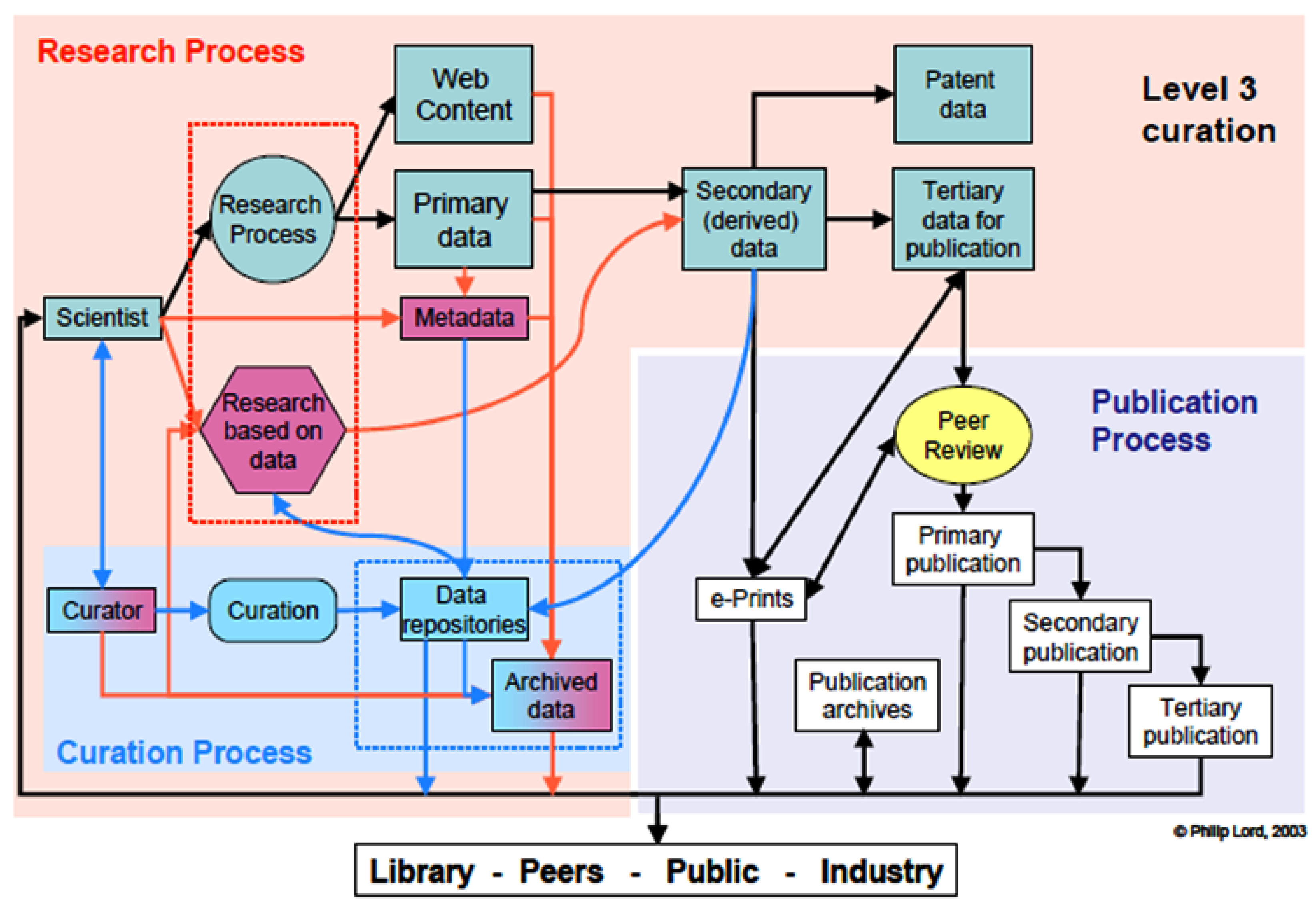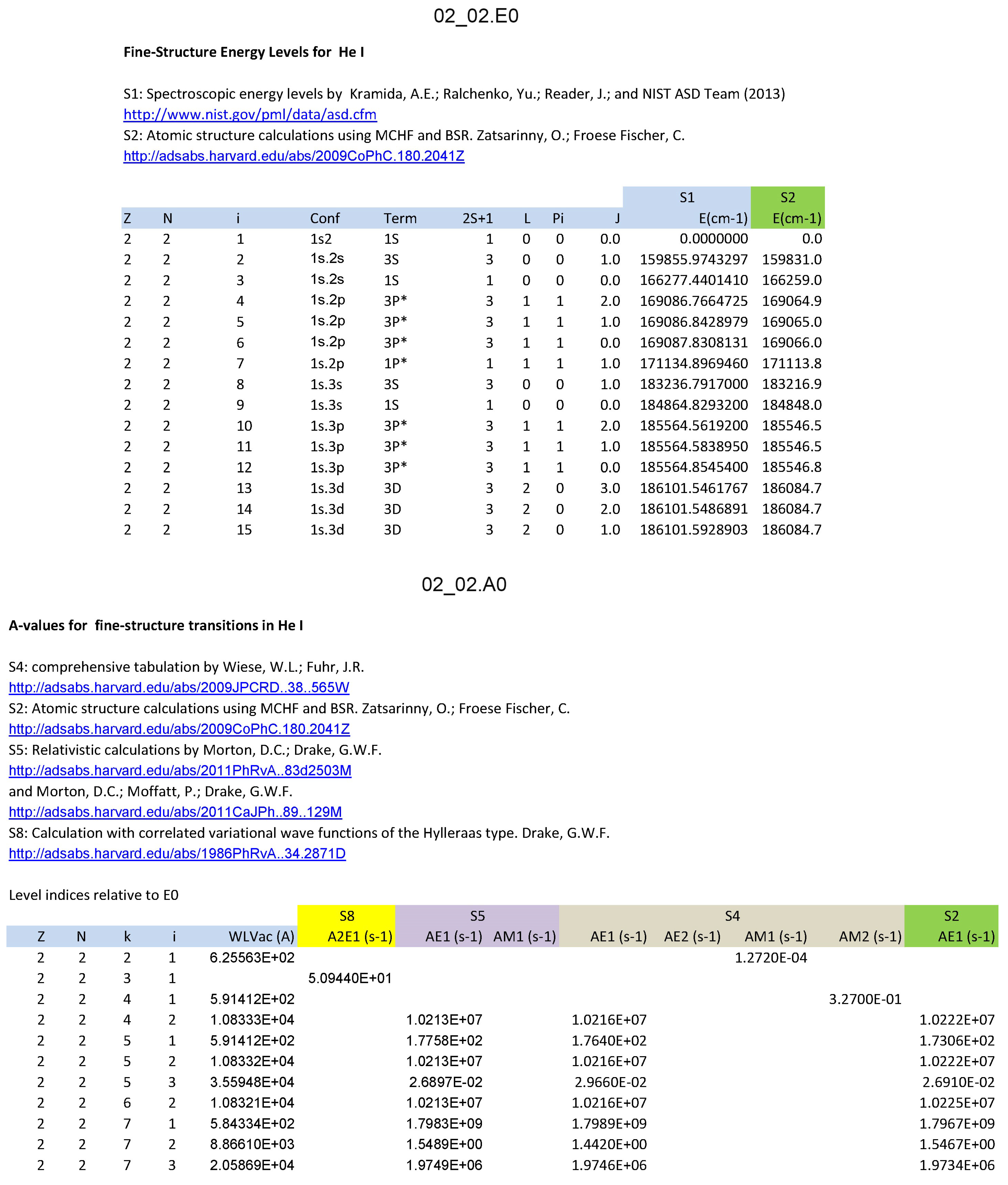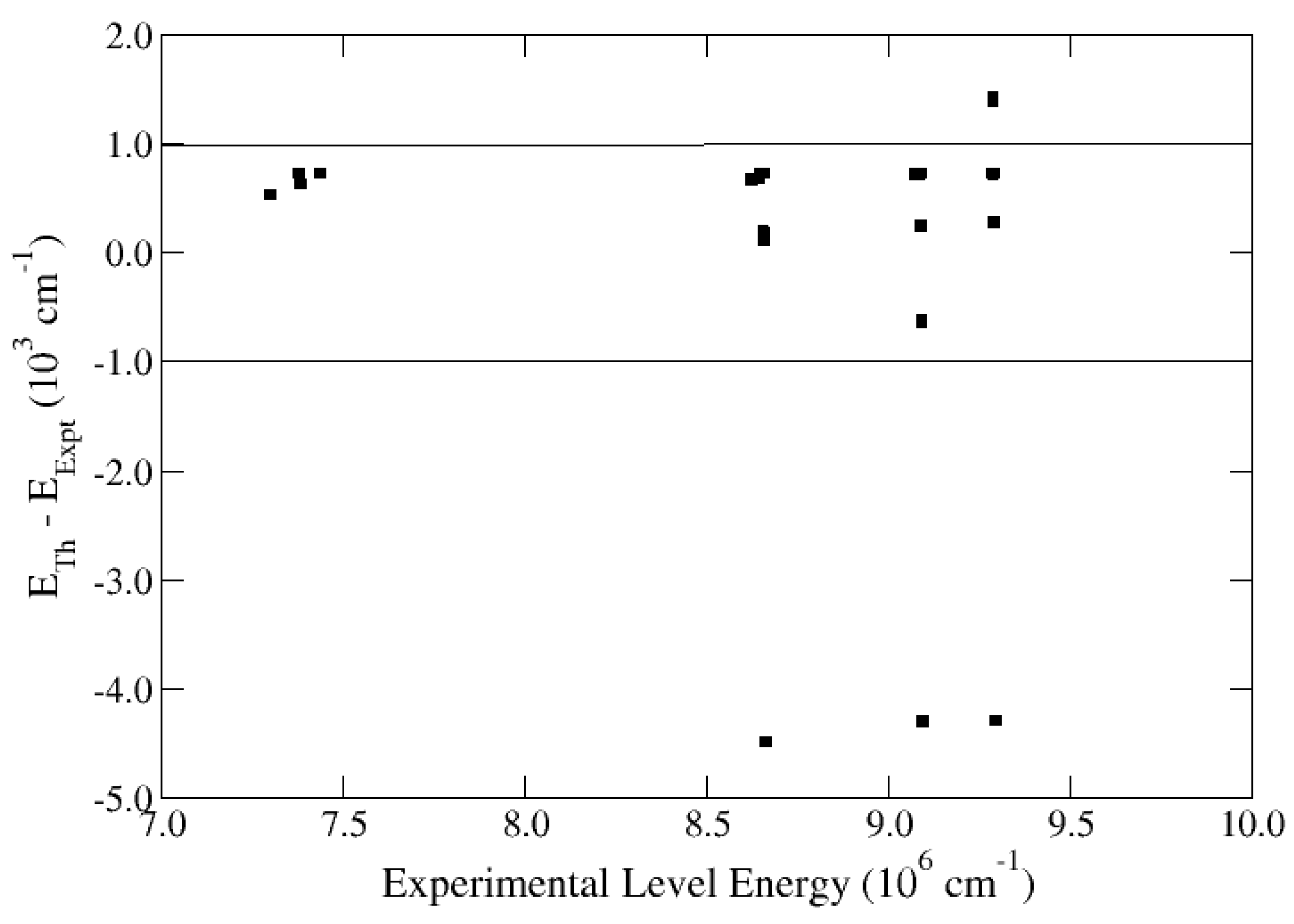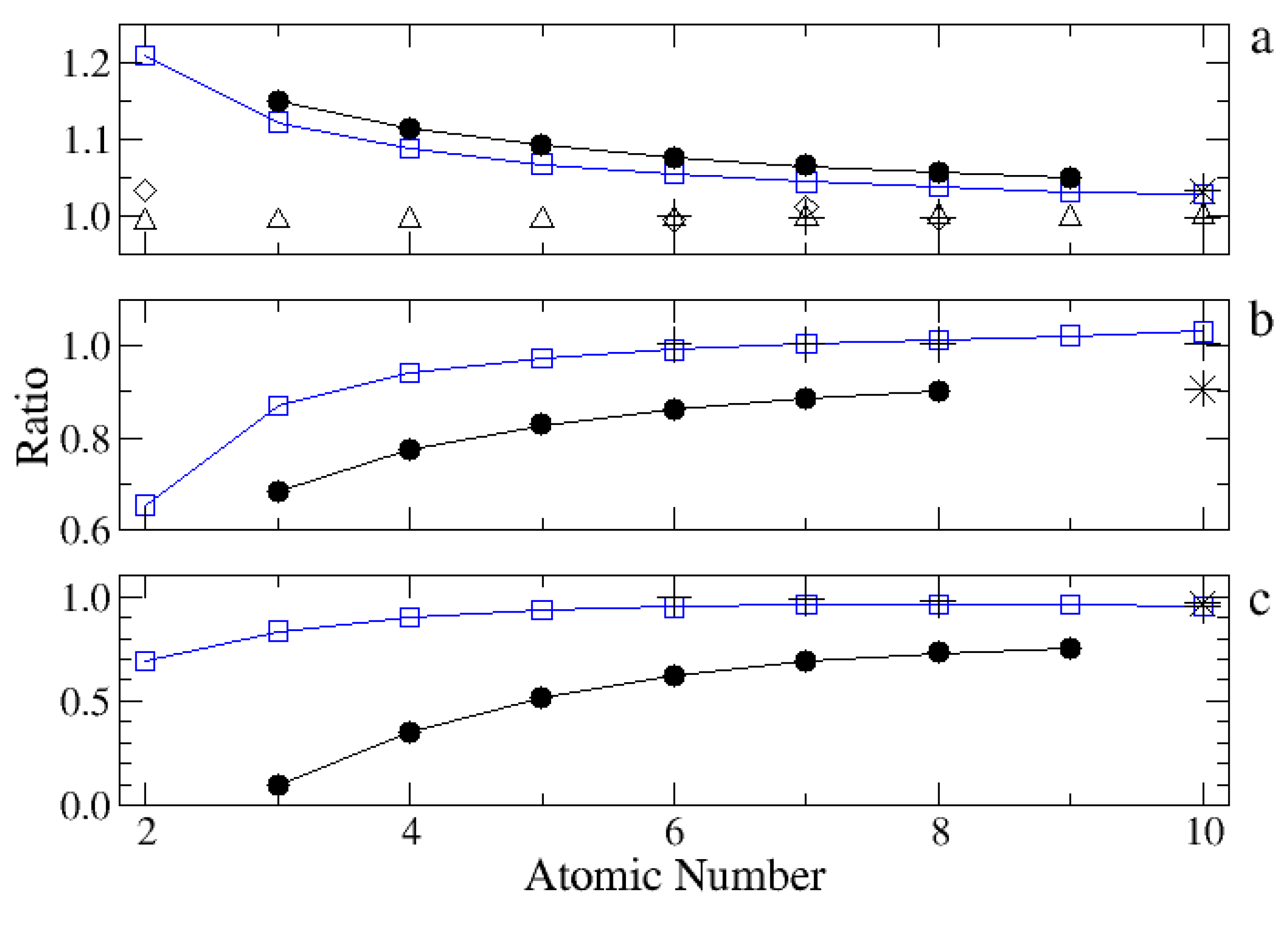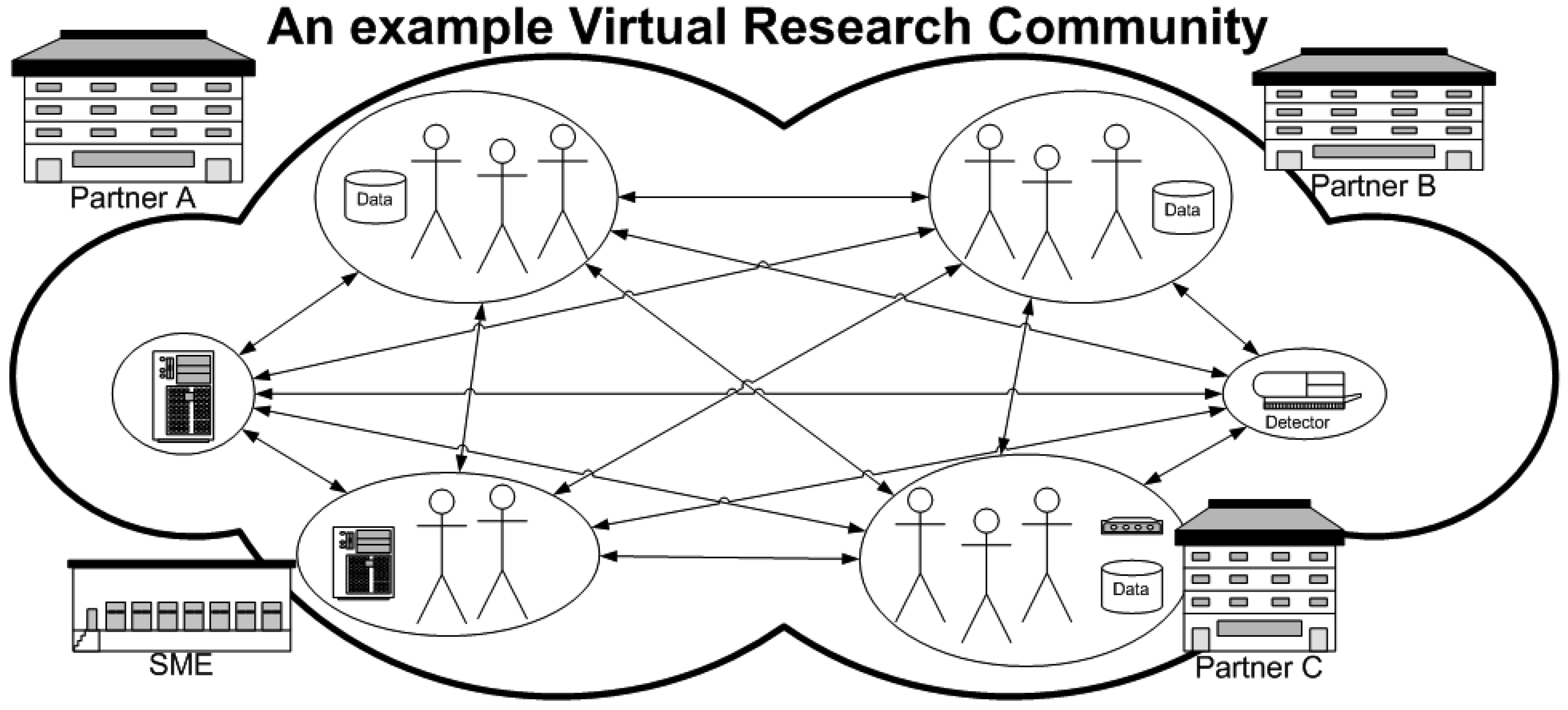5.1. H Sequence
Highly accurate radiative transition probabilities for both allowed and forbidden lines of the hydrogen isotopes (H, D and T) have been critically compiled by Wiese and Fuhr [
88], who recommend scaling laws for other members of the H isoelectronic sequence with low
Z. Also, a noteworthy measurement in one-electron systems is the lifetime of the
level in He
ii at
ps, which is in excellent agreement with theory (99.6891 ps) thus confirming basic radiation theory at the 0.075% level [
89].
Our intention here is to evaluate the accuracy of reported
A-values for H-like systems with
,
and
computed in IC with
superstructure in the context of photoionization–recombination calculations [
90,
91,
92,
93,
94,
95,
96] (these datasets are available online from the
norad-Atomic-Data database [
24],
norad hereafter) and with
grasp as target quality indicators for electron–ion scattering for
[
97] and
[
98]. These two
grasp calculations yield very similar
A-values, although the former did not consider E3 and M3 transitions and gives level energies with and without quantum electrodynamic (QED) corrections. These datasets are located in the
workbooks (
) listed in the AtomPy
IsoelectronicSequences/01 subdirectory.
Since the relativistic
A-values for E1 transitions listed in the online tables [
99] of Jitrik and Bunge [
100,
101] agree with those in [
88] to five significant figures and provide a more complete treatment of the forbidden transitions, we adopt their datasets as the standard for comparison. The relativistic
A-values in [
102] are not included in this study since only E1 transitions for selected ions were therein considered, neither will the two independent relativistic calculations [
103,
104] on the
two-photon transition as they are in almost perfect accord.
Table 1.
Average permyriad (
) differences between the
A-values computed with
grasp [
98] for hydrogenic ions and the standard [
100,
101]. Allowed (E1) and forbidden (E2, E3, M1, M2 and M3) transitions between levels with principal quantum number
in
are considered.
Table 1.
Average permyriad () differences between the A-values computed with grasp [98] for hydrogenic ions and the standard [100,101]. Allowed (E1) and forbidden (E2, E3, M1, M2 and M3) transitions between levels with principal quantum number in are considered.
| Ion | | E1 | E2 | E3 | M1 | M2 | M3 |
|---|
| H i | | 6 | 6 | 6 | 500 | 6 | 6 |
| He ii | | 4 | 2 | 2 | 90 | 2 | 2 |
| Li iii | | 5 | 1 | 2 | 85 | 2 | 2 |
| Be iv | | 3 | 1 | 2 | 62 | 1 | 1 |
| B v | | 2 | 1 | 2 | 13 | 1 | 1 |
| C vi | | 2 | 1 | 1 | 12 | 1 | 1 |
| N vii | | 1 | 1 | 1 | 3 | 1 | 1 |
In
Table 1, we tabulate average relative differences between the
A-values computed with
grasp [
98] for transitions involving levels with principal quantum number
in H-like ions (
) and those in the standard datasets [
100,
101]. In this comparison, we only include transitions with
, and excellent agreement (a few parts in
) is found except for M1 transitions. For H-like ions with low
Z, such transitions have very small line strengths and, thus, very small
A-values; furthermore, the M1 transition operator in some of the computer packages is coded in its exact relativistic form, while in others the Breit two-body corrections are added to the zero-order term
where
is the
electron angular momentum operator and
is twice its spin operator [
105,
106]. These higher order corrections can lead to remarkable contributions (orders of magnitude in some cases) to the matrix element in H-like systems. In particular, four M1 transitions, namely
,
,
and
, have very small
A-values (
) showing discrepancies as large as an order of magnitude. It may also be appreciated in
Table 1 that the differences subside as
Z increases, and by
they are expected to be less than 1 part in
.
Table 2.
Problematic
A-values (s
) for E3, M2 and M1 forbidden transitions in H
i.
jb: standard reference [
100,
101].
grasp: computed with
grasp [
98].
norad: computed with
superstructure [
96] and listed in the
norad database.
autos: computed with
autostructure in the present work. Note:
.
Table 2.
Problematic A-values (s) for E3, M2 and M1 forbidden transitions in H i. jb: standard reference [100,101]. grasp: computed with grasp [98]. norad: computed with superstructure [96] and listed in the norad database. autos: computed with autostructure in the present work. Note: .
| | jb | grasp | norad | autos |
|---|
| | 1.2575E−05 | 1.2582E−05 | 1.96E−05 | 1.258E−05 |
| | 3.9297E−05 | 3.9319E−05 | 1.57E−04 | 3.932E−05 |
| | 4.6585E−08 | 4.6610E−08 | 1.87E−07 | 4.661E−08 |
| | 2.2848E−05 | 2.2861E−05 | 9.14E−05 | 2.286E−05 |
| | 5.2400E−07 | 5.2429E−07 | 2.10E−06 | 5.243E−07 |
| | 1.2319E−06 | 1.2326E−06 | 4.93E−06 | 1.233E−06 |
| | 1.2886E−08 | 1.2897E−08 | 1.42E−08 | 1.416E−08 |
| | 6.9292E−09 | 6.7907E−09 | 1.93E−08 | 1.036E−08 |
| | 1.0479E−10 | 1.0501E−10 | 2.02E−10 | 1.339E−10 |
| | 3.3801E−09 | 3.3816E−09 | 2.95E−09 | 2.949E−09 |
| | 7.5163E−09 | 7.5361E−09 | 8.45E−09 | 8.452E−09 |
| | 5.3686E−10 | 5.3726E−10 | 5.58E−10 | 5.580E−10 |
| | 5.3029E−07 | 5.1953E−07 | 5.32E−07 | 5.305E−07 |
| | 4.3213E−09 | 4.8205E−09 | 1.23E−08 | 6.533E−09 |
| | 6.0462E−11 | 6.1245E−11 | 1.31E−10 | 8.091E−11 |
| | 5.3957E−13 | 5.4042E−13 | 8.59E−13 | 6.385E−13 |
| | 5.4500E−11 | 5.4461E−11 | 5.95E−11 | 5.948E−11 |
| | 1.7386E−09 | 1.7351E−09 | 1.45E−09 | 1.446E−09 |
| | 1.9206E−10 | 1.9206E−10 | 1.83E−10 | 1.833E−10 |
| | 1.4421E−11 | 1.4318E−11 | 1.23E−11 | 1.232E−11 |
| | 4.3994E−11 | 4.3919E−11 | 9.17E−11 | 5.231E−11 |
| | 1.4489E−12 | 1.4493E−12 | 2.40E−12 | 1.620E−12 |
Statistical comparisons with the
A-values in the
norad database for the H isolectronic sequence—namely allowed and forbidden transitions between states with
in
,
and
[
90,
91,
92,
93,
94,
95,
96]—are impaired by the low number (
i.e., 3) of significant figures with which they have been tabulated. Therefore, for the E1 and E2 transitions, we can only assert that their accuracy is around or better than 1%. For the E3, M1 and M2 transitions, on the other hand, we have found some problems that are perhaps associated to an early, untested prototype of
superstructure used to compute these radiative data. While the
A-values for some transitions are reasonably accurate, for others significant discrepancies appear and many are missing. For instance, the listed
are found to be accurate to better than 1% except for
, which differs by 60% (see
Table 2), and
,
and
are not quoted. Only five M2 transitions are given, and as shown in
Table 2, their
A-values are a factor of four too high suggesting an algebraic bug. These inconsistencies have been verified with
A-values computed with
autostructure by us that are also tabulated in
Table 2. Furthermore, the problems previously discussed involving M1 transitions also manifest themselves in this comparison; for the M1 transitions listed in
Table 2, there are definite correlations among the four datasets but also some outstanding mismatches.
5.2. He Sequence
As emphasized in the critical compilation of transition probabilities for ions of H, He and Li [
88], radiative rates for He-like ions have been extensively treated by high-precision variational and asymptotic expansion methods that provide the standard reference data for this sequence [
105,
107,
108,
109,
110,
111,
112,
113,
114,
115,
116], most of which have already been incorporated in the
nist database (v5.1). The two-photon decay rates of the
and
metastable levels have also been systematically treated for
in an
ab initio relativistic CI approach [
117], finding good agreement with the standard [
109] and confirming that
throughout the isoelectronic sequence.
We would like to nonetheless evaluate the radiative datasets for both allowed and forbidden transitions involving levels with principal quantum number
in this sequence computed by different methods: (i) IC energies and E1
A-values for
calculated with the B-spline
R-matrix method in combination with the
mchf structure code [
118]; (ii)
term energies and E1
A-values for
and
listed in the
norad database obtained with the
R-matrix method in a 10-state target approximation in the context of electron–ion recombination and photoionization studies [
90,
95,
119,
120]; (iii)
A-values for E1, E2, M1 and M2 transitions in
and
computed with a relativistic CI method [
121]; (iv) relativistic energies and
A-values for allowed and forbidden transitions computed with atomic structure codes to implement targets for electron–ion scattering, namely
with
grasp [
122,
123,
124,
125] and
and
with
superstructure [
126,
127,
128].
As can be confirmed in the
02_02 AtomPy workbook, the IC energies computed with the combined
R-matrix–
mchf method in [
118] for He
i are on average
cm
from those listed in the
nist tables. Also, their
A-values for E1 transitions are within 2% of the standard [
88] except for intercombination transitions with very small rates,
, for which the differences are somewhat larger (
%); e.g.,
,
,
and
. In general, this may be regarded as outstanding agreement.
The
norad term energies computed with the
R-matrix method for He
i [
95] are also found to be below the
nist spectroscopic values, in this case by
cm
. This comparison can be extended to the
A-values computed with the same method for this system in the OP [
129] and listed in TOPbase [
9], resulting in a somewhat smaller average difference of
cm
. In our opinion, this noticeable improvement is the result of the inclusion of pseudo-states in addition to spectroscopic states, namely,
in the OP hydrogenic target models (the pseudo-orbitals
and
are introduced to respectively account for the dipole and quadrupole polarizabilities of the
). In contrast,
norad only considered the spectroscopic target states
for this sequence. Nonetheless, the accuracy ranking of the
A-values obtained in these two calculations is comparable (
% with respect to the standard [
88]) except for the transitions listed in
Table 3. The discrepant OP transitions are between
states that are energetically very close and thus are subject to cancellation effects and wavelength corrections. The problematic transitions in
norad are between
states that would probably need further CI to attain convergence.
Table 3.
A-values (s
) for E1 transitions in He
i that show discrepancies larger than 10% with respect to the critical compilation of [
88] (
wf).
norad: rates from the
norad database computed with the
R-matrix method in a 10-state approximation [
95].
op: results from the OP [
129] listed in TOPbase. Wavelengths are determined from the
nist term values.
Table 3.
A-values (s) for E1 transitions in He i that show discrepancies larger than 10% with respect to the critical compilation of [88] (wf). norad: rates from the norad database computed with the R-matrix method in a 10-state approximation [95]. op: results from the OP [129] listed in TOPbase. Wavelengths are determined from the nist term values.
| | λ (Å) | wf | norad | op |
|---|
| | 2.1619E+06 | 5.6862E+01 | 5.706E+01 | 6.73E+01 |
| | 4.1370E+06 | 2.2222E+01 | 2.230E+01 | 2.71E+01 |
| | 3.5849E+05 | 1.8738E+04 | 1.890E+04 | 1.65E+04 |
| | 1.8100E+05 | 5.8221E+04 | 5.876E+04 | 5.10E+04 |
| | 4.0377E+04 | 2.3336E+06 | 2.586E+06 | |
| | 4.0564E+04 | 4.5778E+04 | 5.153E+04 | |
| | 1.8691E+04 | 1.2220E+07 | 1.384E+07 | |
| | 4.0409E+04 | 1.8294E+06 | 2.587E+06 | |
| | 4.0545E+04 | 3.3200E+04 | 5.113E+04 | |
| | 1.8702E+04 | 8.9780E+06 | 1.383E+07 | |
The
norad database also lists
terms and radiative data for E1 transitions in higher members of the He sequence, namely
, computed with the
R-matrix method [
119,
120], where a healthy situation similar to
is encountered (see the AtomPy
06_02, 07_02 and
08_02 workbooks).
norad and OP term energies for these systems are again found to be on average below those in the
nist spectroscopic database: for the former,
,
and
cm
in comparison with the slightly better OP differences of
,
and
cm
resulting from the more effective target approximations. In general, the
norad and OP
values are well within 5% of the standard, except for
transitions with very small
that undergo strong cancellation effects.
The level energies
and
computed with the relativistic CI method of [
121] are of sufficient accuracy to encourage the evaluation of the spectroscopic data of the
nist database (v5.1). For
, the
nist level energies originate from the measurements of [
130], and on average, the difference with theory is found to be a remarkable
cm
. For the other species, they are taken from the unpublished level list in [
131] that has not been critically assessed by
nist, and although the agreement with theory is not as good, it enables the detection of poor measurements. As shown in
Figure 5, the differences with theory for Ne
ix are within the band
cm
except for six levels:
,
,
and
, whose experimental energy positions could perhaps be due for a revision.
Figure 5.
Level energy differences in Ne
ix between the theoretical values of [
121] and the experimental data listed in the
nist database (v5.1). Such differences are mostly bound to the interval
cm
except for six levels whose spectroscopic positions are open for a revision.
Figure 5.
Level energy differences in Ne
ix between the theoretical values of [
121] and the experimental data listed in the
nist database (v5.1). Such differences are mostly bound to the interval
cm
except for six levels whose spectroscopic positions are open for a revision.
For E1 transitions, the
computed in [
121] are within 0.7% of the standard except for
and
; that is,
transitions subject to the strong aforementioned cancellation effects. Furthermore, their
forbidden transitions are also in good accord (
%) except for the sensitive intercombination transitions
that are
%. The most revealing comparison, in fact, is of the electric quadrupole rates
computed by Savukov
et al. [
121] with those by Godefroid and Verhaegen [
108] using the
mchf method and Cann and Thakkar [
112] by means of explicitly correlated wave functions. Apart from satisfactory agreement (
%), it brings out incorrect data for
in the
nist database (v5.1); as indicated in the
nist web page, the
A-values by Cann and Thakkar [
112] are listed for this transition for
while those by Godefroid and Verhaegen [
108] for
. However, as demonstrated in
Table 4, the
nist A-values for
are low by a factor of 2/3, which appears to indicate the use of incorrect statistical weights in the conversion formula from
-values to
A-values; it may also be therein appreciated the excellent overall agreement that prevails among the theoretical data.
Table 4.
Comparison of the
(s
) electric quadrupole (E2) rate showing the incorrectly assigned data in the
nist database (v5.1) for
. GV: [
108] computed with the
mchf method. CT: [
112] using explicitly correlated functions. SJS: [
121] computed with a relativistic CI method. Excellent agreement is otherwise found among the computed
A-values. Wavelengths are determined from the
nist level energies.
Table 4.
Comparison of the (s) electric quadrupole (E2) rate showing the incorrectly assigned data in the nist database (v5.1) for . GV: [108] computed with the mchf method. CT: [112] using explicitly correlated functions. SJS: [121] computed with a relativistic CI method. Excellent agreement is otherwise found among the computed A-values. Wavelengths are determined from the nist level energies.
| Z | λ (Å) | nist | gv | ct | sjs |
|---|
| 2 | 5.3733E+02 | 1.2990E+03 | 1.293E+03 | 1.299E+03 | |
| 3 | 1.7817E+02 | 8.2665E+04 | 8.254E+04 | 8.267E+04 | |
| 4 | 8.8381E+01 | 9.2668E+05 | 9.253E+05 | 9.267E+05 | |
| 5 | 5.2720E+01 | 5.1458E+06 | 5.139E+06 | 5.146E+06 | |
| 6 | 3.4995E+01 | 1.2960E+07 | 1.944E+07 | 1.946E+07 | 1.936E+07 |
| 7 | 2.4914E+01 | 3.8470E+07 | 5.770E+07 | 5.775E+07 | 5.715E+07 |
| 8 | 1.8638E+01 | 9.6560E+07 | 1.448E+08 | 1.450E+08 | 1.423E+08 |
Table 5.
Average differences (
cm
) between the spectroscopic level energies of the
nist database (v5.1) and those computed with
grasp (
[
124],
[
123],
[
122],
[
125]) and
superstructure (
e [
128],
[
126],
[
127]).
grasp1: excludes Breit and QED effects.
grasp2: includes Breit and QED effects. The quantity in brackets gives the standard error.
Table 5.
Average differences ( cm) between the spectroscopic level energies of the nist database (v5.1) and those computed with grasp ( [124], [123], [122], [125]) and superstructure (e [128], [126], [127]). grasp1: excludes Breit and QED effects. grasp2: includes Breit and QED effects. The quantity in brackets gives the standard error.
| | grasp1 | grasp2 | superstructure |
|---|
| | | | |
| | | | |
| | | | |
| | | | |
| | | | e |
| | | | |
| | | | |
| | | | e, |
We now proceed to analyze the IC energy and radiative datasets obtained with structure codes: species
[
122,
123,
124] and
[
125] computed with
grasp and
[
126,
128] and
[
127,
128] with
superstructure, which are contained in the AtomPy
zz_02 workbooks. In
Table 5, we tabulate for these species the average differences between the spectroscopic level energies listed in the
nist database (v5.1) and those obtained with
grasp and
superstructure; it must be noted that, for
, they have been calculated with and without the Breit and QED corrections. For
, the
grasp average differences are approximately constant at
cm
, and the inclusion of the Breit and QED corrections does not lead to significant reductions. By contrast, for
the
grasp average difference is an order of magnitude smaller (
cm
) and so are those obtained with
superstructure for other ions, a level of agreement more compatible with that encountered in the calculation by [
121]. It must also be appreciated that, for
, the
superstructure energy differences are both positive and negative depending on authorship. In conclusion, the general outcome of this exercise seems to indicate that a variety of strategies for atomic model optimization have been employed—some more successful than others—and due to their relevance in the final data products, a great deal of pondering and effort must go into the atomic system representation.
Moreover, we have found that only a fraction of the published
A-values for He-like ions computed with
grasp are in reasonable agreement (within 10%, say) with the standard and the accurate dataset by [
121]. This fraction is
%–60% for E1 transitions and somewhat lower or similar for the forbidden transitions:
%–50% for E2 and M1 and
%–60% for M2, and it tends to increase slowly with
Z. The
A-values calculated in [
127] for
with
superstructure are mainly for 17 strong E1 transitions (
) that are found to be in good agreement (better than 10%) with the standard except for
.
Figure 6.
Ratio of theoretical
A-values for selected transitions relative to the standard [
110,
113]. (
a)
; (
b)
and (
c)
. Filled circles: calculations with
grasp for
[
122,
123,
124]. Star: calculation with
grasp for
[
125]. Squares: calculation with
autostructure, present work. Crosses: relativistic CI calculation [
121]. Diamonds:
A-values from the
norad database computed with the
R-matrix method [
95,
119,
120]. Triangles: OP [
129].
Figure 6.
Ratio of theoretical
A-values for selected transitions relative to the standard [
110,
113]. (
a)
; (
b)
and (
c)
. Filled circles: calculations with
grasp for
[
122,
123,
124]. Star: calculation with
grasp for
[
125]. Squares: calculation with
autostructure, present work. Crosses: relativistic CI calculation [
121]. Diamonds:
A-values from the
norad database computed with the
R-matrix method [
95,
119,
120]. Triangles: OP [
129].
In order to illustrate the problems in such datasets, we plot in
Figure 6 the ratio relative to the standard [
110,
113] of
A-values computed with different methods for three transitions along the isoelectronic sequence: the
resonance (E1) transition, the
M1 transition within
and the
E2 transition. For the E1 transition, it may be seen that, in comparison with the
R-matrix (including OP) [
95,
119,
120,
129] and the relativistic CI method of [
121], the data computed with
grasp are noticeably higher (
%) for low
Z, which seems to indicate insufficient correlation. We have also calculated
A-values for the He-like ions
with autostructure using atomic models containing the configurations
with
, and as shown in
Figure 6a, for
they are not much different from those by
grasp. More comparable values are obtained with
autostructure for low
Z by adopting the CI expansions of [
108]:
with
,
and
; however, the
A-values are found to be very sensitive to the choice of the
scaling parameter of the statistical model potential used to generate the 1s orbital, not making it easy to arrive at an optimized value variationally. Single-excitation CI expansions of the type in Equation (
4) have been extensively used for He-like targets in scattering calculations, while those in Equations (
5) and (
6), which include double excitations, would rapidly lead to unmanageable collisional targets. However, the quality of a collisional target is determined to a great extent by the accuracy of its radiative signatures; therefore, targets built up with poor CI expansions can lead to unreliable collision strengths. Furthermore, the situation with the M1 and E2 transitions in
Figure 6b,c is not much different,
i.e., distinctively discrepant
A-values for low
Z, but in this case
autostructure performs somewhat better than
grasp. Again, more accurate
A-values for low
Z can be obtained with
autostructure with the double-excitation CI expansions [
108]
This unconverged correlation in He-like collisional targets becomes more acute for excited states as shown in
Figure 7 where we plot
for
and
and
. Firstly, there is excellent agreement between the OP
A-values [
129] and those obtained with the relativistic CI calculation of [
121]. On the other hand, the differences with the data computed with
grasp for C
v [
124] and Ne
ix [
125] are significant and grow with
n; for C
v, the relative difference between
grasp and [
121] for
is a factor of three (see
Figure 7). It may also be seen that
A-values computed with
autostrcuture show this similar discouraging behavior.
Figure 7.
as a function of
n for (a)
and (b)
. Circles:
mcdf calculation with
grasp for
[
124]. Stars:
mcdf calculation with
grasp for
[
125]. Squares: Breit–Pauli CI calculation with
autostructure, present work. Crosses: relativistic CI calculation [
121]. Triangles: OP [
129].
Figure 7.
as a function of
n for (a)
and (b)
. Circles:
mcdf calculation with
grasp for
[
124]. Stars:
mcdf calculation with
grasp for
[
125]. Squares: Breit–Pauli CI calculation with
autostructure, present work. Crosses: relativistic CI calculation [
121]. Triangles: OP [
129].
Table 6.
Experimental and theoretical lifetimes (s) for states in He
i. Experiment:
[
133];
[
134];
[
135];
[
136];
[
137];
[
138];
[
139];
[
140]. Theory:
[
88];
[
118]. Note: the quantity in brackets gives the experimental error.
Table 6.
Experimental and theoretical lifetimes (s) for states in He i. Experiment: [133]; [134]; [135]; [136]; [137]; [138]; [139]; [140]. Theory: [88]; [118]. Note: the quantity in brackets gives the experimental error.
| | Experiment | Theory |
|---|
| | | |
| | | , |
| | | , |
| | | , |
| | , e | , |
| | , | , |
| | | , |
| | | , |
| | | , |
| | | , |
| | | , |
| | | |
| | , | , |
| | | , |
| | | , |
| | | , |
| | | |
| | | , |
Table 7.
Experimental and theoretical lifetimes (s) for states in He-like ions.
[
141];
[
132];
[
142];
[
143];
[
144];
[
145];
[
146];
[
147];
[
148]. Theory:
[
88];
[
149];
[
150];
[
121];
[
105]. Note: the quantity in brackets gives the experimental error.
Table 7.
Experimental and theoretical lifetimes (s) for states in He-like ions. [141]; [132]; [142]; [143]; [144]; [145]; [146]; [147]; [148]. Theory: [88]; [149]; [150]; [121]; [105]. Note: the quantity in brackets gives the experimental error.
| | Experiment | Theory |
|---|
| | | |
| | | |
| | | |
| | | , |
| | e | , |
| | e | , |
| | | , |
| | e | |
| | e | , |
| | | , |
| | | |
| | | , |
| | | |
| | | |
| | | |
| | | , |
Table 8.
Experimental and theoretical transition rates (s
) for He-like ions.
[
151];
[
152];
[
153];
[
154];
[
144];
[
147]. Theory:
[
88];
[
118];
[
107];
[
121]. Note: the quantity in brackets gives the experimental error.
Table 8.
Experimental and theoretical transition rates (s) for He-like ions. [151]; [152]; [153]; [154]; [144]; [147]. Theory: [88]; [118]; [107]; [121]. Note: the quantity in brackets gives the experimental error.
| | Experiment | Theory |
|---|
| | , |
| | |
| , | , |
| , | , |
| | , |
| | , |
| | , |
| | , |
| | , |
| | |
There have been extensive measurements of level lifetimes in He-like ions which, taking advantage of the high accuracy of the theoretical data, have led to useful benchmarks and progressive refinement of a variety of experimental methods. In
Table 6 and
Table 7 we give a representative but by no means exhaustive comparison between experiment and theory for
. It may be appreciated that the portfolio for He
i includes excited states with
while for
it is limited to
, but in most cases the theoretical lifetimes lie within the experimental error bars. Outstanding agreement (better than 1%) is found for
and
, except for
where it deteriorates to
% due to experimental limitations of the heavy-ion storage ring [
132]. The accord for
and
is found to be within 5%.
As shown in
Table 8, measurements have also been reported for the transition rates
and
, where the agreement with theory is within 3% except for
.
